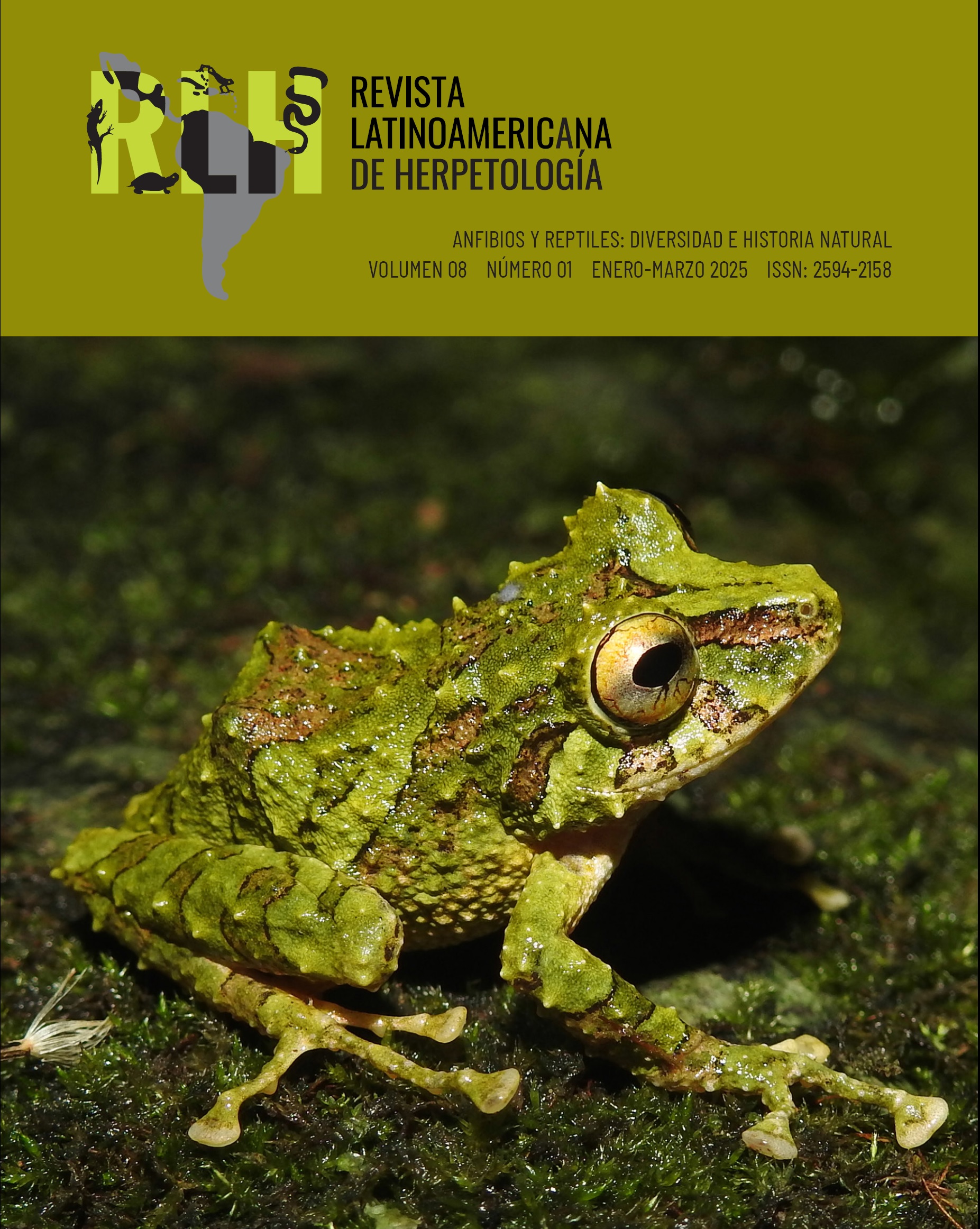DEPREDACIÓN DE LA RANA DE VIDRIO GRANULADA Cochranella granulosa (CENTROLENIDAE) POR LA ARAÑA Eriophora edax (ARANEIDAE)
DOI:
https://doi.org/10.22201/fc.25942158e.2025.1.1159Palabras clave:
Anfibios, Costa Rica, dieta, telas de araña, presaResumen
Aunque numerosos informes documentan la depredación de ranas por arañas, esta interacción sigue siendo poco comprendida. La mayoría de los eventos de depredación entre ranas y arañas se atribuyen a arañas fosoriales y errantes, con solo el 9 % involucrando arañas tejedoras de telarañas. La rana Cochranella granulosa es relativamente común en Costa Rica, especialmente en bosques lluviosos de tierras bajas y montanos. Aquí, informamos un caso de depredación de esta rana por la araña Eriophora edax, una especie nocturna tejedora que construye telarañas grandes y fuertes capaces de capturar pequeños vertebrados voladores. Esta observación tuvo lugar el 6 de octubre de 2017 a las 21:50 h en el campus de Atenas de la Universidad Técnica Nacional en Costa Rica. Este incidente marca solo la segunda instancia registrada de Eriophora edax depredando vertebrados. Presentamos y discutimos este caso en el contexto de otros casos documentados de depredación de ranas por arañas.
Citas
Barrio-Amorós, C.L., A.M. Forero-Cano, F.R. Serna, R. Nieto & C. Rombeaut. 2022. Extension of the distribution of Cochranella granulosa (Taylor, 1949) in Colombia and Ecuador. Anartia 35:33-38.
Cambronero, A.V., P. Marín, L.I. López & J.M. Mora. 2022. Predation of a Drab Streamside Tree frog Smilisca sordida (Anura: Hylidae) by the Bromeliad spider (Cupiennius coccineus) in Northwestern Costa Rica. Revista Latinoamericana de Herpetología 5:20-24.
Ceballos L., Y. Hénaut & L. Legal. 2005. Foraging strategies of Eriophora edax (Araneae, Araneidae): A nocturnal orb-weaving spider. Journal of Arachnology 33:509-515.
Culebras, J., F.N. Angiolani-Larrea, J. Tinajero-Romero, C. Pellet & J. Yeager. 2020. First record and notable range extension of the Glass frog Cochranella granulosa (Taylor, 1949) (Anura, Centrolenidae) found in Ecuador. Herpetology Notes 13:353-355.
de Oliveira Meneses, A.S., B.A.A. Peña Corrêa, M.D.A. Ramos Fernandes, B.E. Pires de Camargos Lopes, N. Kaladinsky Citeli & R. Albuquerque Brandão. 2021. What size of Neotropical frogs do spiders prey on? Biologia 76:919-932.
Duellman, W.E. & L. Trueb. 1986. Biology of Amphibians. McGraw-Hill, New York, New York, USA.
Folt, B. & W. Lapinski. 2017. New observations of frog and lizard predation by wandering and orb-weaver spiders in Costa Rica. Phyllomedusa 16:269-277.
Greenstone. M.H. 1984. Determinants of web spider species diversity: vegetation structural diversity vs. prey availability. Oecologia 62:299-304.
Guayasamín, J.M., S. Castroviejo-Fisher, L. Trueb, J. Ayarzagüena, M. Rada & C. Vila. 2009. Phylogenetic systematics of Glassfrogs (Amphibia: Centrolenidae) and their sister taxon Allophryne ruthveni. Zootaxa 2100:1-97.
Guayasamín, J.M., D.F. Cisneros-Heredia, R.W. McDiarmid, P. Peña & C.R. Hutter. 2020. Glassfrogs of Ecuador: Diversity, evolution, and conservation. Diversity 12:1-285.
Heiling A. 1999. Why do nocturnal orb-web spiders (Araneidae) search for light? Behavioral Ecology and Sociobiology 46:43-49.
Höfer, H. & A.D. Brescovit. 2000. A revision of the Neotropical spider genus Ancylometes Bertkau (Araneae: Pisauridae). Insect Systematics & Evolution 31:323-360.
Holdridge, L.R. 1967. Life Zone Ecology. Tropical Science Center, San José, Costa Rica.
Levi, H.W. 1970. The ravilla group of the orb weaver genus Eriophora in North America (Araneae: Araneidae). Psyche 3:280-302.
Meraz, L.C., Y. Hénaut & L. Legal. 2012. Prey selection in a nocturnal web-building spider, Eriophora edax (Araneae Araneidae). Ethology Ecology & Evolution 24:1-13.
Mora, J.M., R. Alvarado & H.A. Lara. 2023. Predation of a Yellow-Headed gecko (Gonatodes albogularis) by a bromeliad spider Cupiennius coccineus. Revista Latinoamericana de Herpetología 6:6-12.
Núñez Escalante, R.N. & J. Moreno Chinchilla. 2021. Predation by a tarantula (Sericopelma immensum) on a terciopelo (Bothrops asper) in Sierpe de Osa, Costa Rica. Reptiles & Amphibians 28:490-491.
Nyffeler, M. 1999. Prey selection of spiders in the field. Journal of Arachnology 27:317-324.
Nyffeler, M. & M. Knörnschild. 2013. Bat predation by spiders. PLoS ONE 8:e58120.
Nyffeler, M. & R.S. Vetter. 2018. Black widow spiders, Latrodectus spp. (Araneae: Theridiidae), and other spiders feeding on mammals. The Journal of Arachnology 46:541-548.
Nyffeler, M. & R. Altig. 2020. Spiders as frog-eaters: a global perspective. The Journal of Arachnology 48:26-42.
Pérez Galvis, J.S., C. Martinez-Vargas & J. Gutierrez-Toro. 2024. Predation attempt by a Wandering Spider, Ancylometes bogotensis (Aranae: Ctenidae), on a Western Basilisk, Basiliscus galeritus (Squamata: Corytophanidae). Reptiles & Amphibians 31:e21806.
Pough, F.H., R.M. Andrews, J.E. Cadle, M.L. Crump, M.L., A.H. Savitzky & K.D. Wells. 2001. Herpetology. Prentice Hall, Upper Saddle River, New Jersey, USA.
Prémel, V. & J.P. Torres. 2021. Cupiennius sp. (Taczanowski, 1874), predation on the tree frog Dendropsophus carnifex (Duellman, 1969) in Ecuador. Herpetology Notes 14:117-120.
Reyes‐Olivares, C., A. Guajardo‐Santibáñez, B. Segura, N. Zañartu, M. Penna & A. Labra. 2020. Lizard predation by spiders: a review from the Neotropical and Andean regions. Ecology and Evolution 10:10953-10964.
Ruíz-Carranza, P.M. & J.D. Lynch. 1991. Ranas Centrolenidae de Colombia I: propuesta de una nueva clasificación genérica. Lozania 57:1-30.
Savage, J.M. 2002. The Amphibians and Reptiles of Costa Rica: a Herpetofauna Between Two Continents, Between Two Seas. University of Chicago Press, Chicago, Illinois, USA.
Descargas
Publicado
Cómo citar
Número
Sección
Licencia
Derechos de autor 2025 Revista Latinoamericana de Herpetología

Esta obra está bajo una licencia internacional Creative Commons Atribución-NoComercial-CompartirIgual 4.0.







